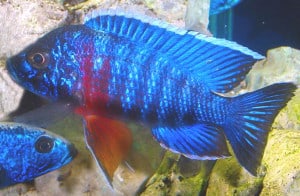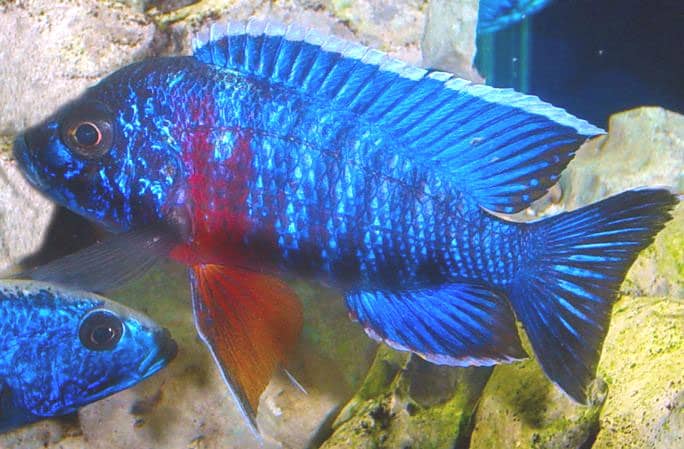
Common name: Peacock Cichlid, Peacock, Blue Peacock, Red Peacock
Scientific name: Aulonocara Hansbaenschi
Average Adult Fish Size: 14cm / 5 Inches
Place of Origin: Lake Malawi
Typical Tank setup: Rocky Malawi tank
Recommended Minimum Aquarium Capacity: 160 Litres
Compatibility: Other Lake Malawi cichlids, but Mbunas should be avoided. Haplochromis species usually work quite well.
Temperature: 23-28 Deg C / 73-82 Deg F
Water chemistry: pH 7.6-8.6
Feeding: Peacocks care omnivorous and can easily be fed in an aquarium on suck live or frozen foods as: bloodworms, mosquito larvae, crustaceans, snails, and Tubifex. These fish also readily take pellets and flakes.
Sexing: Males become brightly colored even as juveniles. Females remain grey colored.
Breeding: Peacock Cichlids are ovophile mouthbrooders that form a matriarch family. The pair should be conditioned separately on mosquito larvae, bloodworms, and crustaceans. The water should have a pH from 8.0-8.2, a water hardness 10-18 dH, and a warmer temperature of 79-84°F (26-29°C). The female spawns a small number of eggs on the rocky bottom. These are fertilized by way of the dummy-egg method. The young should be raised on newly hatched Artemia and fine-grade flake foods.
Additional Information: Located at the east coastline from Cobue in Mozambique to Makanjila Point in Malawi. Found in intermediate zones where sand and rocks intermix. Diet in the wild consists of microinvertebrates taken off the rocks and in the sand. The aquarium should have some rockwork but still provide open swimming space both along the bottom and mid-tank region. Feed a quality cichlid flake/pellet food, supplement occasionally with frozen brine, krill or mysis. Keep one male to several females, do not keep with other Aulonocara species as hybridization can occur. Mouth breeder, mother cares for the eggs (till 60). The mother lays the egg and takes them in her mouth, then the male presents his egg-dots on his fin, the female thinks, it are eggs, too, wants to take them too, and the male can fertilize the eggs. After 3 weeks the mother will let the fries go, and if there are enough places to hide probably many will grow up. The Blue Peacock Cichlid does well in an aquarium that is at least 50 gallons with plenty of rocks for territories and a sandy bottom. The male is usually only aggressive towards its own species unless its territory is invaded upon. Provide a ratio of 3 to 4 females to one male. The male Blue Peacock’s colors will become more vivid during breeding time. The yellow will become more pronounced and his temperament will become more aggressive. Again, provide multiple females for the male, as it will take the stress off of the female carrying the eggs. Incubation is approximately 3 weeks, at which time, the female will release the fry. Provide the fry with newly hatched brine shrimp and finely ground flake food.


Related Posts
Croaking Gourami – Trichopsis vittatus
Benthochromis Tricoti
Large-eyed Mouthbrooder – Callochromis Macrops